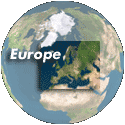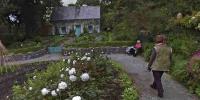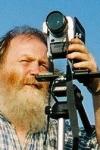
A Garden within a Garden
Glenveagh National Park, County Donegal, Ireland
24, June 2006 - 12:15 UTC (12:15 local time)
© 2006 George Row, All Rights Reserved.
Glenveagh National Park consists of 17,000 hectares of mountain land surrounding the steeply sided glaciated valley that contains Lough Veagh. It is home to one of Ireland's last herds of red deer and recently was the site for the re-introduction into the wild of the golden eagle. The focal point for many visitors is Glenveagh Castle - which is set in 11 hectares of gardens. They are laid out as a network of mainly informal gardens, each with a different theme.
History
The Glenveagh estate was created in 1859 through the purchase of several smaller holdings by John George Adair. In 1861 Adair became infamous throughout Ireland by evicting 250 tenants from the land. Many of the dispossessed emigrated to Australia.
The last private owner of the estate was Henry Mcilhenny - an American whose family owned the Tabasco Sauce company. He bought it in 1931. In 1975 Glenveagh Estate was bought from him by the Irish government and in 1981 Mr McIlhenny presented Glenveagh Castle and gardens as a gift to the Irish nation.
Once described by Andy Warhol as 'the only person in Philadelphia with glamour', Mcilhenny spent just three months each year at Glenveagh. Over the years he hosted a huge range of glamourous people at the castle covering a spectrum from Marilyn Monroe to Yehudi Menuhin.
The Gardens
Henry Mcilhenny invested huge sums into improving and enlarging the gardens, much of it following the advice of the landscape designer Lanning Roper and the great plantsman James Russell.
Pines and ponticum rhododendrons provide windbreaks to allow ornamental rhododendrons and delicate plants from as far afield as Chile, Madeira and Tasmania to survive and flourish. The best times to see the gardens are said to be in May and early June when the rhododendrons are at their best or in August, when the Walled Garden is at its most colourful.
The Park is managed by the Irish National Parks and Wildlife services. While access to the park itself is free, there is a visitors centre, a bus along the lake to the castle, tour guides and two coffee shops all of which earn revenue for the park.
The Panorama
This panorama was taken inside the Walled Garden, that is next to the castle. We are positioned outside the gardener's cottage. Hence the panorama opens looking at the gardener's garden inside the walled garden within the Glenveagh gardens.
It was created from three rows of twelve images and two "down" shots for the ground beneath the tripod.
My method went like this:
a) The three rows were stitched using Calico
b) The stitched image was cleaned up a bit in photoshop. This included lightening the shadows to bring out detail and patching over a few places where the stitching boundary had blurred the image, or movement in the overlaps had produced ghosts. I deliberately left the foliage on the back of Mary Kay's jacket (the walking figure on the right of the opening shot).
c) The cleaned stitched image was rendered as a set of six Cubic VR sides using Cubic Converter
d) The bottom face of the cube consisted mostly of a large hole - this was filled in using the "down" shots. (I admit it! Some of the gravel was cloned from elsewhere in the image.)
e) The top face of the cube consisted mostly of a large hole - this was filled by copying clouds from elsewhere in the image.
f) All six faces were then reduced to a quarter of their size.
g) The six faces were then taken back into Cubic Converter and a final version was rendered.
Calico is a new stitcher from Kekus based on the work of Matthew Brown (a PhD student at the University of British Columbia)
I am really pleased with Calico and with this as a first Cubic.
I took several VR panoramas of Glenveagh that day. They are on my Very Ireland website, including a hugely higher resolution version (12Mb).


 Tap or click the zoom icon in the bottom right corner of the picture to switch between in-page and fullscreen view
Tap or click the zoom icon in the bottom right corner of the picture to switch between in-page and fullscreen view